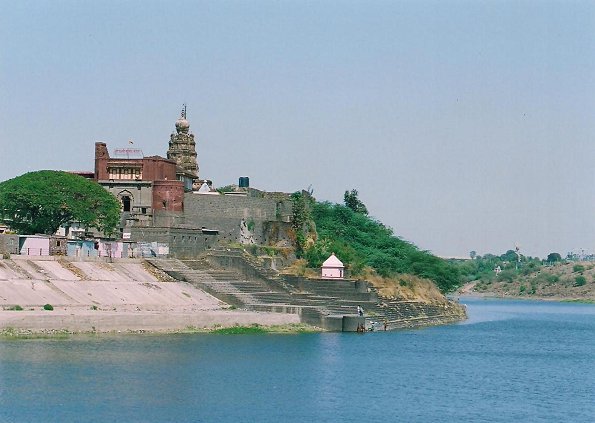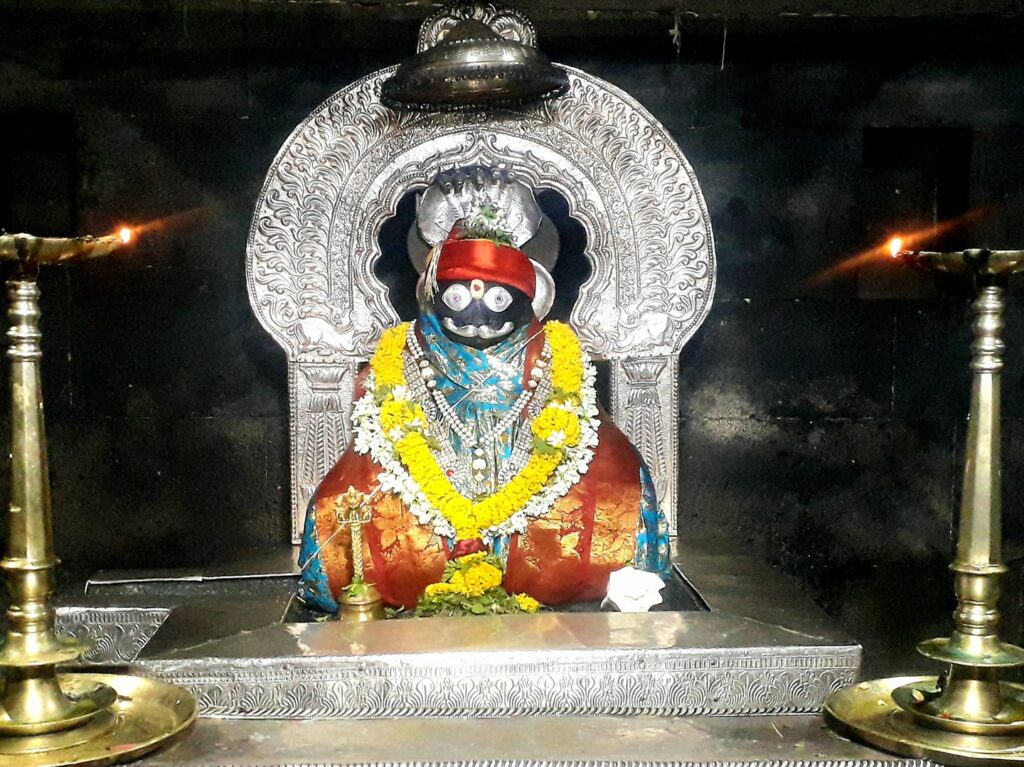
Nira Narsingpur is the abode of Sri Lakshmi Narasimha on the banks of the sacred Nira river in the Indapur Taluka of Pune district in Maharashtra (India). Though not on the banks of the sacred Bhima river, the river is visible clearly from one side of the temple. The temple’s proximity to the longer and wider Bhima river can be ascertained from the presence of the Nira-Bhima Sangam i.e. confluence near the temple.
Nira Narsingpur is the last village of Pune district in the south-east direction. The presence of two sacred rivers around Nira Narsingpur and the scenic greenery is very pleasing to devotees coming for the darshan of Sri Lakshmi Narasimha Swamy. It gives them extra energy and focus to meditate upon the Lord. You could sit gazing at the mesmerizing beauty of this region the entire day and yet not be bored.
Sri Nira Narasimha is the family Deity of many families in Maharashtra. Moreover, the Deity here was the family Deity of the Vijayanagar dynasty too. Swami Samarth Ramdas had visited and performed worship at Nira Narsingpur twice on his way to Pandharpur.
The temple follows the Madhwa-sampradaya system of worship. Therefore, you will come across the shrine of Sri Raghavendra Swami built by the Uttaradi Mutt here. Srila Vyasadeva had resided here.
Vedic History of Nira Narsingpur
In the Satya-yuga, when Hiranyakashipu went away to engage in severe penances to please Lord Brahma, the devatas decided to kill his child who was growing in the womb of his wife Queen Kayadhu. They thought that, being an asura, Hiranyakashipu was dangerous for the existence of the three worlds, his son would become a bigger and dangerous asura.
But Sage Narada came to know about it before the devatas could execute their plan. He advised the devatas against killing the child in the womb of Queen Kayadhu as the child was a great devotee of Lord Vishnu. After stopping the devatas from executing their plan, Sage Narada went to Hiranyakashipu’s palace and took Queen Kayadhu away to his ashram at the confluence of the Nira and Bhima rivers.
This was done to ensure the safety of the great devotee of Lord Vishnu, who was growing in the womb of the Queen.
At the ashram, Sage Narada instructed Queen Kayadhu in Vishnu bhakti. As the Queen listened to his instructions, the child growing in her womb listened too. The child got initiated in Vishnu bhakti, lying in his mother’s womb. Hence, the child was born as a devotee of Lord Vishnu and named Prahlada.
Bhakta Prahlada Makes a Deity
In the time spent at Sage Narada’s ashram before shifting to his father’s palace, Bhakta Prahlada spent time engaging in devotional service to Lord Vishnu. During this time, he made a Deity of Lord Narasimha from sandstone. Some devotees believe that the Deity was made from sand.
The very same Deity of Lord Narasimha, made by Bhakta Prahlada is being worshipped in Nira Narsingpur to this day. Another beautiful Deity of Lord Narasimha worshipped in the temple is called Shyamraj, which was consecrated by Lord Brahma.
Deities of Nira Narsingpur Temple
There are two main Deities of Lord Narasimha in the temple. One deity of Sri Lakshmi Narasimha was made by Bhakta Prahlada from sandstone / sand, while the other Deity called Shyamraj was consecrated by Lord Brahma. Both Deities are very beautiful.

It is interesting to note that Bhakta Prahlada made a beautiful Deity of Lord Narasimha from sandstone at a very young age. This speaks volumes about his devotion. The Deity has remained intact over the years due to the yearly application of diamond powder on its body.
Other Deities
There are many other deities in the temple complex too. These include Lakshmi Devi, Bhakta Prahlada, Lord Bhimashankar, Lord Ganesha (Chintamani), Lord Dattatreya, Lord Kala Datta, Sri Vittal Rukmini, Lord Tarati Narasimha, Lord Kashi Vishweshwara, Lord Muhrat Ganapati, Shakambari Devi, Lord Kaal Bhairava, Lord Rameshwara, Nandideva and Sri Raghavendra Swami (incarnation of Bhakta Prahlada).
There is a big round stone called Shaligrama near the Shakambari Devi temple.
Architecture of Nira Narsingpur Temple
Like the other temples of the Maharashtra region, this temple too has a majestic and appealing architecture. It represents some of the finest ideas and elements of the Peshwa era architecture. Built on fine blocks of stones stacked on each other, the outer circular portions of the complex have been built using bricks.
The temple was originally built in the 12th century. The present-day temple structure was renovated by Sardar Vithal Shivadev Dani during the reign of the Maratha dynasty in 1787 CE. It took him 20 years to complete the entire renovation. And seven years within those 20 years were spent fixing the foundation which had deteriorated due to the flowing river.
He was inspired by his Guru Amrutswami to renovate the temple especially being his family Deity. Parts of the temple complex have been repaired or other additions have been done by other patrons over the years.
The temple has three entrances i.e. east, west and north. Two big elephants at the eastern and western entrances welcome devotees to the temple. The western entrance, known as the Moksha Dwar is the largest and most attractive. You need to climb 33 steps in order to enter the temple. Many finely carved pillars mark the hall before the Gabhara i.e. sanctum.
The Shikhara is very colourful, four-tiered and has many beautiful carvings on it. The carvings include animals, riders, deities, etc. The colours on the Shikhara and the remaining top portion of the temple enhance the elegance of the temple. Yellow is the main colour used followed by other colour shades such as red, green, orange, etc.
The Special Gong at Nira Narasingpur
A big bell has been placed at the western entrance of the Nira Narsingpur temple. This bell was earlier in the possession of the Portuguese Church. After capturing Vasai from the Portuguese in 1739 CE, Peshwa Chimaji Appa Rao, the younger brother of Peshwa Bajirao collected four bells. And among them, one was donated to this temple through Diwan Sadashiv Mankeshwar, the Inamdar of Tembhurni village.
The bell was lifted and hooked in front of the temple by Baba Pahilwan, who had great physical strength. It is said that he single-handedly lifted the bell with his left hand and hooked it using his right hand.
Nira-Bhima Sangam at Nira Narsingpur
The Nira-Bhima Sangam is very significant. The sacred Nira river flows from a well at the foothills of the Sahyadri mountains while the sacred Bhima river originates at the Rathachal mountain.
The sandy banks of the Nira are blackish in colour while that of Bhima are white and shiny. The Nira flows swiftly compared to the Bhima. The Sangam or confluence of these two holy rivers was made easily accessible by building a ghat here. Sri Dhadhoji Mudhoji built the oval-shaped Sangam ghat here.
The steps of this ghat are decorated with idols of animals like elephant, monkeys, etc. A majestic temple with 16 pillars called ‘Solakambhi’ was built here to offer prayers. Many other small temples dedicated to Lord Shiva, Lord Ganesha, Bhakta Hanuman, etc., are present around too.
Leading up to the Sangam Ghat, there are a few holy spots on the banks of both the rivers. Along the banks of the Nira river, you can see Lakshmi Tirtha, Shankha Tirtha, Padma Tirtha, Gada Tirtha, Garuda Tirtha, Narasimha Tirtha, Indra Tirtha, Hamsa Tirtha, Tara Tirtha, Durvasa Tirtha, Kapila Tirtha and Pishachamochana Tirtha.
Along the banks of the Bhima river, you can see the Durga Tirtha, Koti Tirtha, Go Tirtha, Bhanu Tirtha, Chakra Tirtha, Nada Tirtha, Pash Tirtha and Moushal Tirtha.
Bathing at the Sangam Ghat gives you the combined benefits of bathing separately in the Nira and Bhima rivers such as freedom from past sinful reactions.
Festivals of Nira Narsingpur Temple
Narasimha Jayanthi is the major festival celebrated at Nira Narsingpur Temple. Devotees come here in huge numbers on this day. The Narasimha Navaratra festival is celebrated here around the time of the Narasimha Jayanthi over a period of nine days.
On special occasions such as Gudi-Padwa, Vijayadashami, Janmashtami, Diwali, Sankranti, Vaisakhi and Navaratri, special decorations are done and special pujas are performed. New clothes and ornaments are offered to Lord Narasimha, Lakshmi Devi and Bhakta Prahlada.
Temple Timings of Nira Narsingpur Temple
The temple is open for darshan from 5.30 AM in the morning to 9.30 PM in the night. Following are the important Deity worship timings –
Kakad Arati: 5:30 AM
Prath Puja: 7:30 AM (Panchamrit Abhisheka)
Madhyan Puja: 12 PM (Maha-Naivedya which includes Puran Poli, Rice and other eatables)
Sayam Puja: 7:30 PM
Sheja Arati: 9 PM (Milk Naivedya)
Timings will vary during festivals and special occasions.
Best Time to Visit Nira Narsingpur Temple
Anytime throughout the year is fine to visit the temple. But if you desire to see the waters of the two rivers Nira and Bhima flow in its full glory, the monsoon season is the only option you have.
A holy dip at the Sangam can be done anytime of the year.
How to Reach Nira Narsingpur
To get the blessings of Sri Lakshmi Narasimha Swamy at Nira Narsingpur along with many other uniquely ancient temples in the nearby regions, you can go ahead with the Pandharpur Nashik Yatra of Tirtha Yatra worry-free.
Tembhurni is the junction from where you have to turn towards the temple when travelling by road. You can choose the modes of travel as per convenience –
By Road: Solapur is the nearest major urban centre 101 km away. You can get state buses via or up to Tembhurni following which you can get a jeep/autorickshaw/bus to the temple. The Jeep will leave you three kilometres before the temple at the Sangam while the autorickshaw will take you to the door of the temple.
Buses are available from major cities in Maharashtra.
By Rail: Pune Junction Railway Station 171 km away and Daund Junction Railway Station 107 km away are the nearest stations where pan-India trains stop. You can alight here and catch a bus towards Tembhurni.
By Air: Pune Airport is the nearest airport 174 km away. You can fly in here and use the rail or road route to reach the temple.
Nira Narsingpur: Blessed within Blessed Bharata
Nira Narsingpur is extremely sacred for many reasons. Firstly, it is the birthplace of Bhakta Prahlada, the foremost devotee of Lord Narasimha. That too, his birth took place in the ashram of the celebrated Sage Narada. When the Lakshmi Narasimha deity worshipped at the Nira Narsingpur temple itself was made by Bhakta Prahlada and the second deity of Shyamraj consecrated by Lord Brahma, you’ll get the feeling of being in Vaikuntha itself.
The sacred rivers Nira and Bhima flowing on either side of Nira Narsingpur and the presence of so many tirthas on their banks. And ultimately, the confluence of Nira and Bhima are itself very sacred. Clubbed with all of this are the heavenly greenery of nature.
Not a feeling! You are in Vaikuntha indeed! What more could you ask for? There is enough to see, learn and experience!
5










5 Comments On Nira Narsingpur
Vinayak Borkar
Is there any provision for accommodation at Nira Narsinghpur?
Or you have to search accomodation in Tembhurni?
Nira Narasingpur has a Pejawar Mutt.
Ganesh dingare
Shri laxmi narsinh devstan mukhy poojdhikari
Shri.Ganesh nandkumar dingare
Contach no.9096877737
K.Chendra Sekhar
Nice information n good article
Kamalakar
Sri Vilas Ramchandra Dandavate
Main Pujari mobile 9420666068